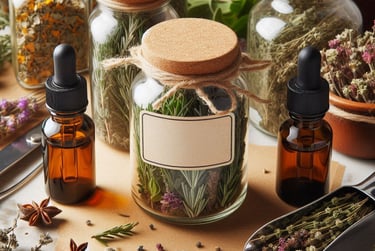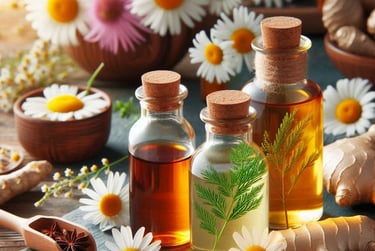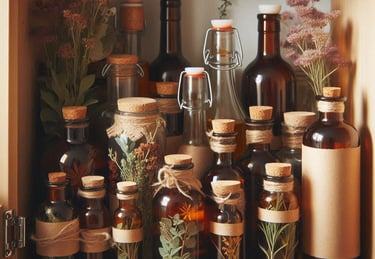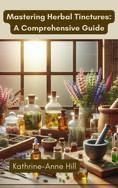How to Make Your Own Herbal Tinctures at Home: Step-by-Step Guide with Recipes for Unique Blends
Learn how to create your own herbal tinctures at home with this step-by-step guide. Explore the essential equipment, ingredient selection, and detailed instructions for crafting effective tinctures tailored to your unique health needs. Discover popular recipes and tips for proper usage and storage, empowering you to harness the full potential of herbal remedies.
HERBAL WISDOM
Kathrine-Anne Hill
8/18/20249 min read


Affiliate Disclaimer:
Please note that some of the links in this article are affiliate links. This means that if you click on these links and make a purchase, I may receive a small commission at no additional cost to you. This commission helps support the maintenance and growth of this website and allows me to continue providing valuable information and recommendations. Rest assured, I only recommend products and services that I have personally used or thoroughly researched. Your support is greatly appreciated! “As an Amazon Associate I earn from qualifying purchases.” For full disclosure see our Privacy Policy and Terms and Conditions here.
Introduction to Herbal Tinctures
Herbal tinctures have been valued for ages as effective botanical preparations, capturing the essence and healing properties of herbs in a convenient form. These concentrated liquid extracts are made by soaking various herbs in alcohol or other solvents, which extract and preserve their active compounds. Traditionally, tinctures have played a vital role in medicine, providing a versatile and powerful way to utilize the healing potential of plants.
The advantages of using herbal tinctures for health and wellness are numerous. They offer a quick and effective way to consume medicinal herbs, ensuring that the body absorbs the active ingredients swiftly. This can be particularly helpful for addressing acute health issues where immediate relief is needed. Additionally, tinctures have a long shelf life, often retaining their potency for several years, making them a valuable addition to any home remedy kit.
One major benefit of making herbal tinctures at home is the level of customization it allows. By creating your own, you can adjust the blends to suit your specific health concerns and preferences, experimenting with different combinations to find what works best for you. This hands-on approach empowers individuals to take charge of their wellness journey, ensuring the use of high-quality and fresh ingredients.
Furthermore, the cost-effectiveness of homemade tinctures is another significant advantage. While store-bought tinctures can be expensive, making them at home can greatly reduce costs. With access to a variety of herbs and simple equipment, you can produce large quantities of tincture for a fraction of the price, providing both economic and therapeutic benefits.
Embracing the practice of making herbal tinctures at home not only fosters a deeper connection with plant medicine but also guarantees a steady supply of personalized, potent remedies tailored to your individual health needs. In the upcoming sections, we will provide a step-by-step guide.
Essential Equipment and Ingredients
When making herbal tinctures at home, having the right equipment and ingredients is crucial for achieving great results. A well-prepared setup starts with a selection of essential tools. Glass jars are vital for both the maceration process and the storage of the tinctures. Quart-size or pint-size glass jars with tight-fitting lids work best, ensuring that the tincture stays uncontaminated during the extraction period.
For storage, dark-colored bottles are the way to go. Amber or cobalt blue bottles protect the tinctures from light exposure, which can diminish the potency of the herbal mixtures. Be sure to label each bottle carefully with the herb names and the preparation date to keep track of potency and avoid any mix-ups.
Measuring tools like graduated cylinders or measuring cups are also important to ensure accurate ingredient ratios. Additionally, a fine-mesh strainer or cheesecloth is necessary for separating the liquid tincture from the plant material after extraction. These filters are key to achieving a clear, debris-free final product.
The effectiveness of any herbal tincture largely depends on the quality of the herbs used. Both fresh and dried herbs can be employed, but it’s important to source them from reputable suppliers. High-quality herbs will produce more potent and effective tinctures. When using fresh herbs, make sure they are thoroughly cleaned and dried to prevent unwanted moisture from entering the tincture.
Alcohol is the primary solvent in most tinctures. Vodka and brandy are popular choices, with an alcohol content of 40-60% being ideal. For those looking for alcohol-free options, glycerin or apple cider vinegar can be used. These solvents extract the medicinal properties of the herbs, although they may not be as potent as alcohol-based tinctures.
By focusing on high-quality ingredients and the right equipment, you can create effective and potent herbal tinctures right at home. Investing in the right tools is essential.
For further reading, my eBook "Mastering Herbal Tinctures: A Comprehensive Guide" is available on google play. This essential resource offers step-by-step instructions, advanced techniques, and expert advice on creating and using tinctures to support your health and wellness journey. Perfect for both beginners and seasoned herbalists, this book provides everything you need to master the art of tincture-making.
Step-by-Step Process to Create Herbal Tinctures
Creating your own herbal tinctures at home is a simple process that starts with choosing the right herbs. Begin by selecting high-quality, organic herbs to guarantee the purity and effectiveness of your tincture. Whether you decide on fresh or dried herbs, it's important to research the unique properties and benefits of each herb. If you're using fresh herbs, make sure to wash them thoroughly to eliminate any dirt or pesticides.
Next, prepare your mixture of alcohol and herbs. A common ratio is 1 part fresh herb to 2 parts alcohol, or 1 part dried herb to 5 parts alcohol. The type of alcohol you use is also significant; vodka or rum with an alcohol content of 40-60% (80-120 proof) is generally recommended for most herbal tinctures. Alcohol serves as a solvent, helping to extract the beneficial compounds from the herbs. Be sure to chop the herbs finely to increase the surface area, which aids in the extraction process.
Once your herbs are ready, place them in a clean glass jar. Pour the alcohol over the herbs, making sure they are completely submerged to prevent mold and bacterial growth. Label your jar with the date and the type of herbs used, which will help you track the tincture's progress and potency. Maintaining proper hygiene, including clean hands and sanitized equipment, is crucial at this stage to avoid contamination.
Seal the jar tightly and give it a good shake. Store the jar in a cool, dark place, such as a pantry or cupboard, and shake it daily to ensure the herbs are evenly distributed. This process allows the alcohol to effectively extract the desired medicinal properties. Typically, tinctures should sit for at least 4-6 weeks, but you can let them infuse for up to six months for a stronger extract. Regular shaking and stable temperature storage are key to maintaining the tincture's efficacy.
After the infusion period, strain the mixture through a fine-mesh sieve or cheesecloth into another clean jar or bottle. Be sure to squeeze out every last drop of liquid from the herbs, which now contain the extracted compounds. Discard the solid herb remnants. Store the tincture in a dark glass bottle to protect it from light.
Popular Herbal Tincture Recipes
Creating your own herbal tinctures at home can be a fulfilling and therapeutic experience. In this guide, we will delve into some popular and easy-to-make herbal tincture recipes, each designed to address specific health needs. Whether you seek immune support, relaxation, or digestive relief, these tinctures are straightforward to prepare and effective.
Echinacea Tincture for Immune Support
Ingredients:
1 cup dried echinacea root
2 cups vodka or another high-proof alcohol
Instructions:
Begin by placing the dried echinacea root in a clean glass jar.
Next, pour the vodka over the dried root, ensuring it is fully submerged.
Seal the jar tightly and store it in a cool, dark location for 4-6 weeks, giving it a gentle shake every few days.
Once the tincture has steeped, strain the liquid through a fine mesh strainer or cheesecloth into a clean container.
Finally, store the finished tincture in a dark glass bottle with a dropper for easy use. Tips for Usage: Use this tincture at the first sign of a cold or flu. A typical dose is 1-2 droppers full, taken 2-3 times a day.
Chamomile Tincture for Relaxation
Ingredients:
1 cup dried chamomile flowers
2 cups vodka or another high-proof alcohol
Instructions:
Start by placing the dried chamomile flowers in a clean glass jar.
Pour the vodka over the flowers, ensuring they are completely submerged.
Seal the jar tightly and let it sit in a cool, dark place for 4-6 weeks, shaking gently every few days.
After steeping, strain the liquid through a fine mesh strainer or cheesecloth into a clean container. Store the chamomile tincture in a dark glass bottle with a dropper for convenient access.
Tips for Usage: This tincture is great for promoting relaxation and alleviating anxiety. Take 1-2 droppers full about 30 minutes before bedtime.
Ginger Tincture for Digestion
Ingredients:
1 cup freshly grated ginger root
2 cups vodka or another high-proof alcohol
Instructions:
Begin by placing the freshly grated ginger root in a clean glass jar.
Pour the vodka over the ginger, ensuring it is completely covered.
Seal the jar tightly and store it in a cool, dark place for 4-6 weeks, shaking gently every few days.
Creating Unique Herbal Blends
Exploring the world of herbal tinctures opens up a wealth of opportunities to discover unique blends that cater to individual tastes and health requirements. The art of combining herbs can be guided by principles such as herb compatibility, flavor pairing, and the intended purpose of the blend. By grasping these foundational concepts, one can create tinctures that are both effective and enjoyable.
When selecting herb combinations, it's important to consider the synergistic effects—how different herbs can work together to amplify each other's benefits. A good approach is to begin with a primary herb that addresses a specific health issue. For instance, echinacea, known for its immune-boosting properties, can be paired with elderberry, which has antiviral benefits, resulting in a powerful remedy for colds and flu.
Flavor pairing is another crucial element in tincture creation. The taste of the herbal blend can greatly influence the overall experience. Balancing stronger flavors with milder ones can enhance the tincture's palatability. For example, the bitterness of burdock root can be softened by the sweetness of licorice root, achieving a pleasing balance in both flavor and medicinal effects.
Before you start crafting your blend, it's essential to clearly define its purpose. Are you looking for a digestive aid, a calming remedy, or an energy booster? This clarity will inform your herb selection. A calming tincture might include valerian root, passionflower, and chamomile, all recognized for their soothing and stress-relieving properties. On the other hand, an energy-boosting blend could feature ginseng, peppermint, and ginger for their revitalizing effects.
Encouraging creativity in the process of making herbal tinctures allows for personalization and experimentation. Successful recipes often begin with a solid understanding and evolve through practice. Examples of effective blends include a detoxifying mix of dandelion root, milk thistle, and fennel, or an anti-inflammatory combination of turmeric, ginger, and black pepper. Both blends provide unique health benefits and flavor profiles.
Tips for Using and Storing Herbal Tinctures
Herbal tinctures are powerful liquid extracts derived from various herbs, providing a range of health benefits when used appropriately. To fully utilize these herbal remedies, it’s essential to grasp their correct usage and storage methods.
Typically, the dosage for herbal tinctures falls between 20 to 60 drops, which is about 1-3 milliliters, taken two to three times a day. However, this can vary depending on the specific herb and individual requirements. It’s wise to consult a healthcare professional for personalized dosage advice that aligns with your health conditions and objectives.
Safety is paramount when using herbal tinctures. Certain herbs may interact with medications or pre-existing health issues, so it’s important to exercise caution and seek professional guidance before starting any new herbal routine. Pregnant or nursing women, children, and individuals with serious medical conditions should consult a doctor before use.
Proper storage is key to extending the shelf life of your herbal tinctures and maintaining their effectiveness. Store tinctures in dark glass bottles, away from direct sunlight and temperature fluctuations. A cool, dark area like a cupboard or pantry is ideal. To ensure the best quality, make sure the tinctures are tightly sealed to prevent alcohol evaporation, which serves as a preservative. Generally, well-stored tinctures can maintain their potency for up to five years.
Accurate labeling of your tinctures is essential. Each label should contain the herb's name, the type of alcohol used, the alcohol concentration, and the preparation date. Keeping a detailed log of production dates and ingredients provides a reliable reference for future use, especially when crafting unique blends. By following these guidelines, you can enhance the therapeutic benefits of herbal tinctures while ensuring their safety and effectiveness over time.
Related Posts:
How to Make Your Own Herbal Salves at Home: Ingredients and Instructions
Natural Detox with Herbal Tonics: Cleansing and Rebalancing Your Body
5 Herbal Remedies for Clear and Glowing Skin: Simple Recipes with Common Household Ingredients











